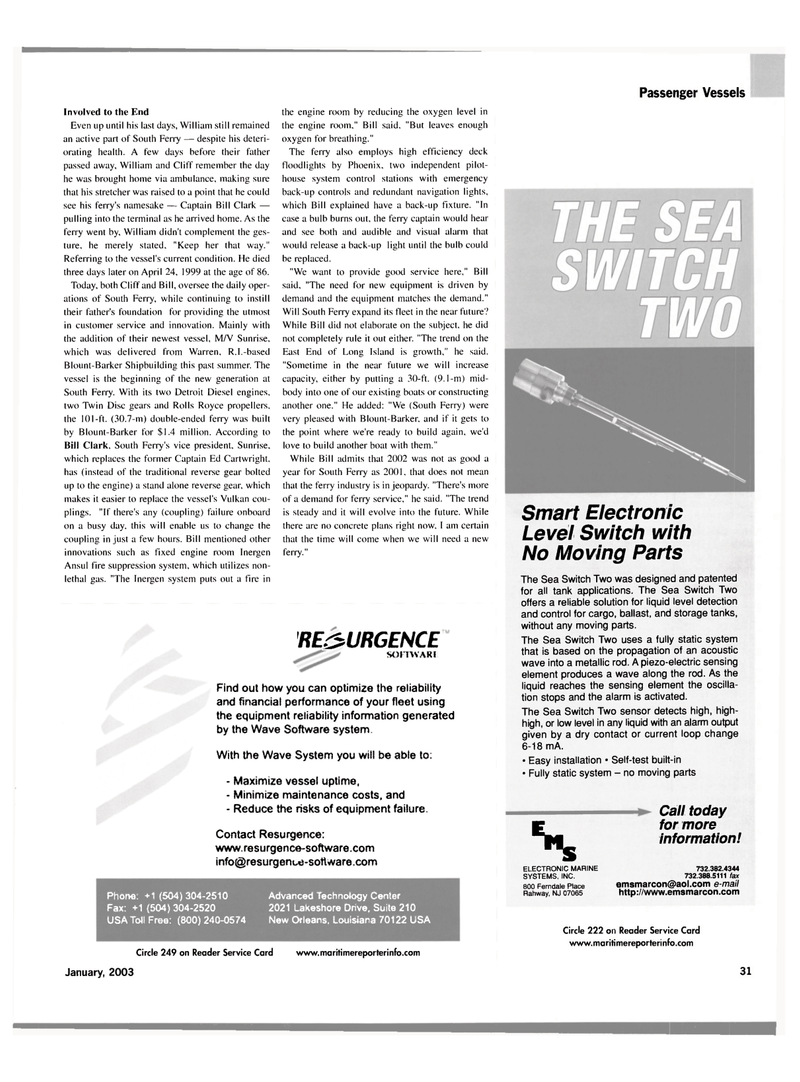
Page 31: of Maritime Reporter Magazine (January 2003)
Read this page in Pdf, Flash or Html5 edition of January 2003 Maritime Reporter Magazine
Passenger Vessels
Involved to the End
Even up until his last days, William still remained an active part of South Ferry — despite his deteri- orating health. A few days before their father passed away, William and Cliff remember the day he was brought home via ambulance, making sure that his stretcher was raised to a point that he could see his ferry's namesake — Captain Bill Clark — pulling into the terminal as he arrived home. As the ferry went by, William didn't complement the ges- ture, he merely stated, "Keep her that way."
Referring to the vessel's current condition. He died three days later on April 24, 1999 at the age of 86.
Today, both Cliff and Bill, oversee the daily oper- ations of South Ferry, while continuing to instill their father's foundation for providing the utmost in customer service and innovation. Mainly with the addition of their newest vessel, M/V Sunrise, which was delivered from Warren. R.I.-based
Blount-Barker Shipbuilding this past summer. The vessel is the beginning of the new generation at
South Ferry. With its two Detroit Diesel engines, two Twin Disc gears and Rolls Royce propellers, the 101-ft. (30.7-m) double-ended ferry was built by Blount-Barker for $1.4 million. According to
Bill Clark, South Ferry's vice president. Sunrise, which replaces the former Captain Ed Cartwright, has (instead of the traditional reverse gear bolted up to the engine) a stand alone reverse gear, which makes it easier to replace the vessel's Vulkan cou- plings. "If there's any (coupling) failure onboard on a busy day, this will enable us to change the coupling in just a few hours. Bill mentioned other innovations such as fixed engine room Inergen
Ansul fire suppression system, which utilizes non- lethal gas. "The Inergen system puts out a fire in the engine room by reducing the oxygen level in the engine room," Bill said. "But leaves enough oxygen for breathing."
The ferry also employs high efficiency deck floodlights by Phoenix, two independent pilot- house system control stations with emergency back-up controls and redundant navigation lights, which Bill explained have a back-up fixture. "In case a bulb burns out, the ferry captain would hear and see both and audible and visual alarm that would release a back-up light until the bulb could be replaced. "We want to provide good service here," Bill said, "The need for new equipment is driven by demand and the equipment matches the demand."
Will South Ferry expand its fleet in the near future?
While Bill did not elaborate on the subject, he did not completely rule it out either. "The trend on the
East End of Long Island is growth," he said. "Sometime in the near future we will increase capacity, either by putting a 30-ft. (9.1-m) mid- body into one of our existing boats or constructing another one." He added: "We (South Ferry) were very pleased with Blount-Barker, and if it gets to the point where we're ready to build again, we'd love to build another boat with them."
While Bill admits that 2002 was not as good a year for South Ferry as 2001, that does not mean that the ferry industry is in jeopardy. "There's more of a demand for ferry service," he said. "The trend is steady and it will evolve into the future. While there are no concrete plans right now. I am certain that the time will come when we will need a new ferry."
RESURGENCE somvARi
Find out how you can optimize the reliability and financial performance of your fleet using the equipment reliability information generated by the Wave Software system.
With the Wave System you will be able to: - Maximize vessel uptime, - Minimize maintenance costs, and - Reduce the risks of equipment failure.
Contact Resurgence: www.resurgenco-software.com info@resurgeni^j-sottware.com
Phone: +1 {504)304-2510
Fax: +1 {504)304-2520
USA Toll Free: {800)240-0574
Advanced Technotogy Center 2021 Lakeshore Drive, Suite 210
New Orleans, Louisiana 70122 USA
Smart Electronic
Level Switch with
No Moving Parts
The Sea Switch Two was designed and patented for all tank applications. The Sea Switch Two offers a reliable solution for liquid level detection and control for cargo, ballast, and storage tanks, without any moving parts.
The Sea Switch Two uses a fully static system that is based on the propagation of an acoustic wave into a metallic rod. A piezo-electric sensing element produces a wave along the rod. As the liquid reaches the sensing element the oscilla- tion stops and the alarm is activated.
The Sea Switch Two sensor detects high, high- high, or low level in any liquid with an alarm output given by a dry contact or current loop change 6-18 mA. • Easy installation • Self-test built-in • Fully static system - no moving parts s
ELECTRONIC MARINE
SYSTEMS, INC. 800 Ferndale Place
Rahway, NJ 07065
Call today for more information! 732.382.4344 732.388.5111 fax [email protected] e-mail http://www.emsmarcon.com
Circle 249 on Reader Service Card www.maritimereporterinfo.com
Circle 222 on Reader Service Card www.maritimereporterinfo.com
January, 2003 31

 30
30

 32
32
